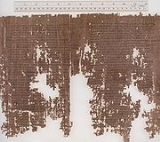
University of Michigan Papyrus Collection
Encyclopedia
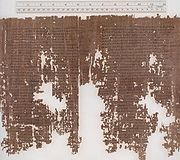
University of Michigan
The University of Michigan is a public research university located in Ann Arbor, Michigan in the United States. It is the state's oldest university and the flagship campus of the University of Michigan...
Library is an internationally respected collection of ancient papyrus
Papyrus
Papyrus is a thick paper-like material produced from the pith of the papyrus plant, Cyperus papyrus, a wetland sedge that was once abundant in the Nile Delta of Egypt....
and a center for research on ancient culture, language, and history. With over 7,000 items and more than 10,000 individual fragments, the Collection is by far the largest collection of papyrus in the country, and offers a glimpse into the everyday life and language of the ancient world. Of keen interest to historians, linguists, classicists, philosophers, archaeologists, as well as others, the collection includes biblical fragments, religious writings, public and private documents, private letters, and writings on astronomy, astrology, mathematics, and magic. The papyri span nearly two millennia of history, dating from about 1000 BC to AD 1000, with the majority dating from the third century BC to the seventh century AD.
Many of the papyri in U-M's collection were written by Greek-speaking
Greek language
Greek is an independent branch of the Indo-European family of languages. Native to the southern Balkans, it has the longest documented history of any Indo-European language, spanning 34 centuries of written records. Its writing system has been the Greek alphabet for the majority of its history;...
people living in Egypt
Egypt
Egypt , officially the Arab Republic of Egypt, Arabic: , is a country mainly in North Africa, with the Sinai Peninsula forming a land bridge in Southwest Asia. Egypt is thus a transcontinental country, and a major power in Africa, the Mediterranean Basin, the Middle East and the Muslim world...
. Their use of common Greek, known as koine, is instructive as to how the ancient dialects gave way to a more standardized language. Although most examples of papyrus originate from Egypt, papyrologists generally study documents which are written in Greek—the official language of the government from the time of Alexander the Great until the Muslim conquest of Egypt
Muslim conquest of Egypt
At the commencement of the Muslims conquest of Egypt, Egypt was part of the Byzantine Empire with its capital in Constantinople. However, it had been occupied just a decade before by the Persian Empire under Khosrau II...
.
History
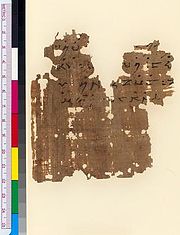
World War I
World War I , which was predominantly called the World War or the Great War from its occurrence until 1939, and the First World War or World War I thereafter, was a major war centred in Europe that began on 28 July 1914 and lasted until 11 November 1918...
was in progress, any purchasing had to wait until after the armistice of 1918. Kelsey then traveled to Egypt to acquire papyri. In February 1920, he arrived in Cairo
Cairo
Cairo , is the capital of Egypt and the largest city in the Arab world and Africa, and the 16th largest metropolitan area in the world. Nicknamed "The City of a Thousand Minarets" for its preponderance of Islamic architecture, Cairo has long been a centre of the region's political and cultural life...
and secured the codex of the Minor Prophets, among many other pieces. Dr. W.W. Bishop, University Librarian of the University of Michigan, was very eager to enlarge the Library's manuscript resources, and assumed responsibility for the housing and care of the papyri, as well as for providing in the Library a work room for those entrusted with their decipherment and publication.
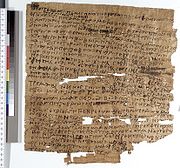
Byzantine
Byzantine usually refers to the Roman Empire during the Middle Ages.Byzantine may also refer to:* A citizen of the Byzantine Empire, or native Greek during the Middle Ages...
period, the administration, the personal religious beliefs of individuals, the official religions and their dogmatic clashes, the history of ancient scholarship, the schools, higher education and changes in literary taste over the periods mentioned. Among the most intriguing texts to have been unearthed are passages from sorcerers' handbooks that disclose magic spells and give instructions on their proper use.
The collection of papyri is augmented by the University's collection of ostraca
Ostracon
An ostracon is a piece of pottery , usually broken off from a vase or other earthenware vessel. In archaeology, ostraca may contain scratched-in words or other forms of writing which may give clues as to the time when the piece was in use...
, which is housed in the Kelsey Museum of Archaeology. Other ancient materials in the Collection include wood and wax tablets (unique in the ancient world because they were eraseable and re-usable).
Professional Activities and Affiliations
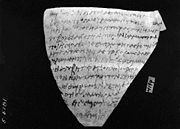
The U-M Papyrus Collection also produces the Bulletin of the American Society of Papyrologists, the only professional journal published in America for the advanced study of papyri and related topics.
Digitization efforts
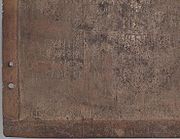
Digitizing
Digitizing or digitization is the representation of an object, image, sound, document or a signal by a discrete set of its points or samples. The result is called digital representation or, more specifically, a digital image, for the object, and digital form, for the signal...
its papyrology collection. New technology has aided the study of the fragile materials, making it more easily accessible. The first digital scanner
Image scanner
In computing, an image scanner—often abbreviated to just scanner—is a device that optically scans images, printed text, handwriting, or an object, and converts it to a digital image. Common examples found in offices are variations of the desktop scanner where the document is placed on a glass...
purchased by the U-M Library was used to begin digitizing its papyrus holdings, according to the Winter 2007 issue of Search and Discovery: Research at Michigan.
The University of Michigan, along with UC Berkeley, Columbia
Columbia University
Columbia University in the City of New York is a private, Ivy League university in Manhattan, New York City. Columbia is the oldest institution of higher learning in the state of New York, the fifth oldest in the United States, and one of the country's nine Colonial Colleges founded before the...
, Duke
Duke University
Duke University is a private research university located in Durham, North Carolina, United States. Founded by Methodists and Quakers in the present day town of Trinity in 1838, the school moved to Durham in 1892. In 1924, tobacco industrialist James B...
, Princeton
Princeton University
Princeton University is a private research university located in Princeton, New Jersey, United States. The school is one of the eight universities of the Ivy League, and is one of the nine Colonial Colleges founded before the American Revolution....
, and Yale
YALE
RapidMiner, formerly YALE , is an environment for machine learning, data mining, text mining, predictive analytics, and business analytics. It is used for research, education, training, rapid prototyping, application development, and industrial applications...
, is a member of the Advanced Papyrological Information System (APIS), a consortium that is working to digitize the member institutions' collections and make them available online. The Michigan APIS database currently has over 35,000 records with images, searchable in a variety of fields including date, language, origin, type of text, author, names of persons, and many more. Also included are detailed electronic images of the papyrus, publication info, and even (in some cases) a link to the Greek text on the Perseus Project
Perseus Project
The Perseus Project is a digital library project of Tufts University that assembles digital collections of humanities resources. It is hosted by the Department of Classics. It has suffered at times from computer hardware problems, and its resources are occasionally unavailable...
website.

